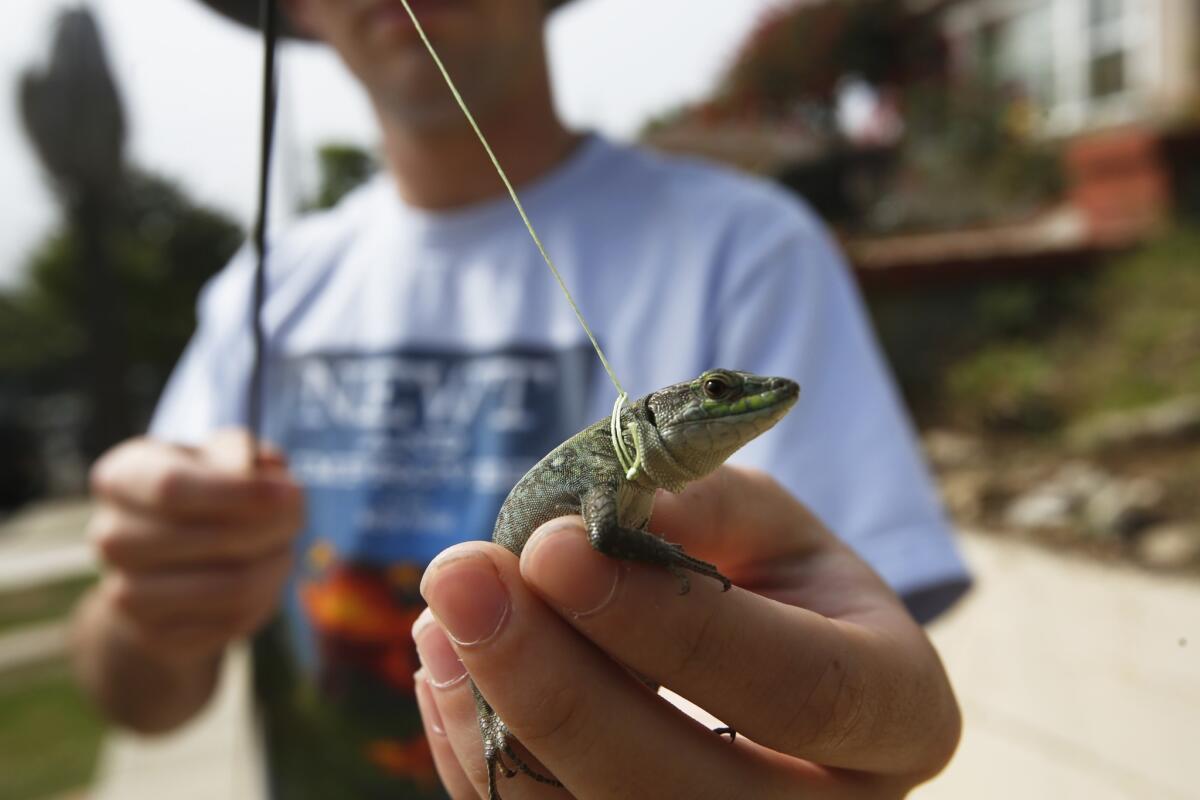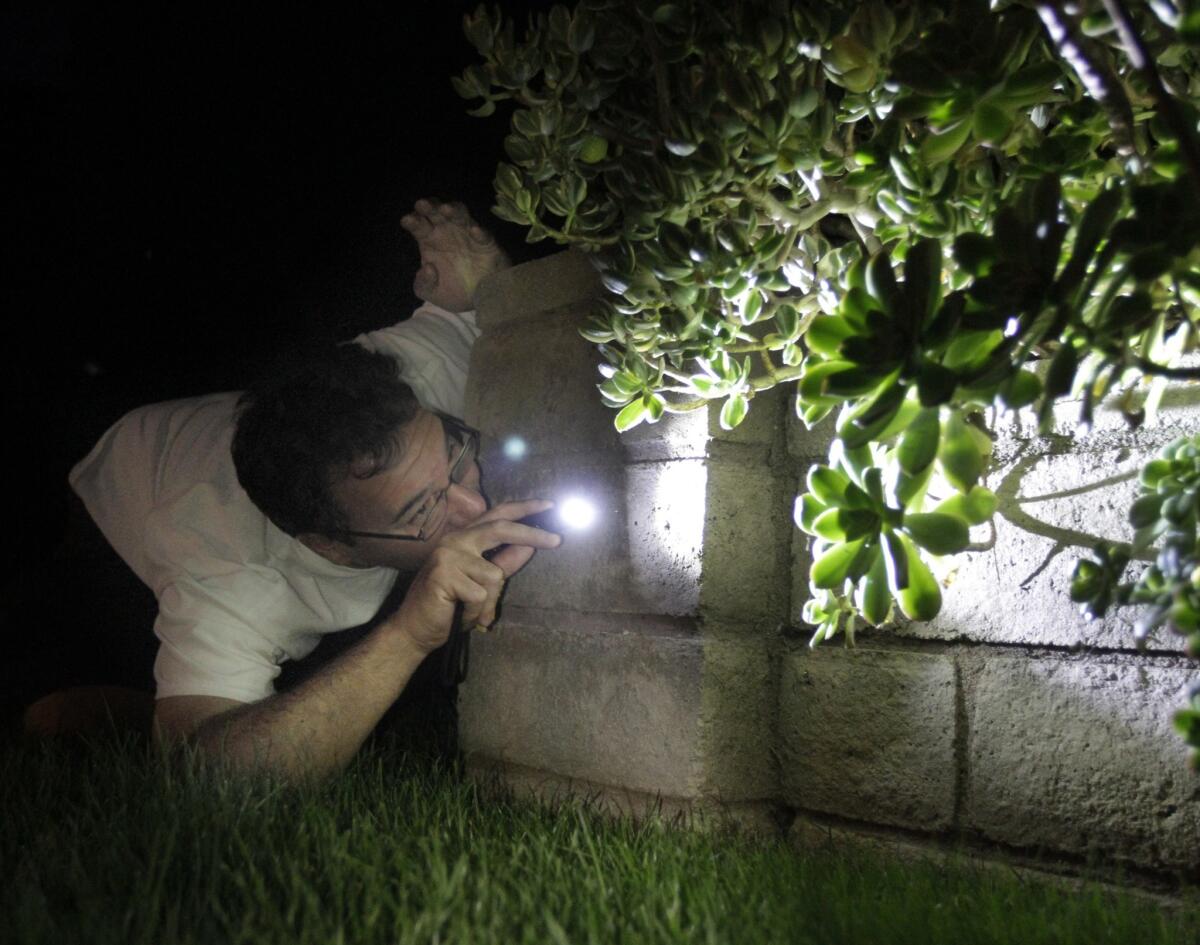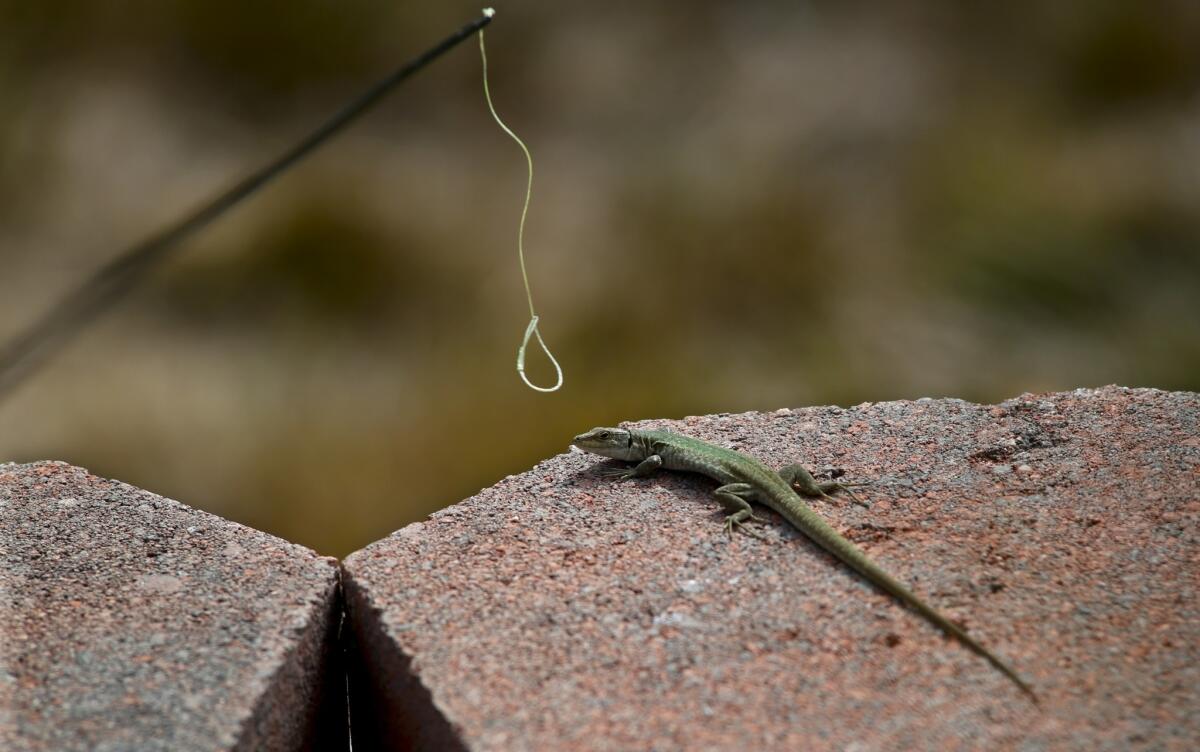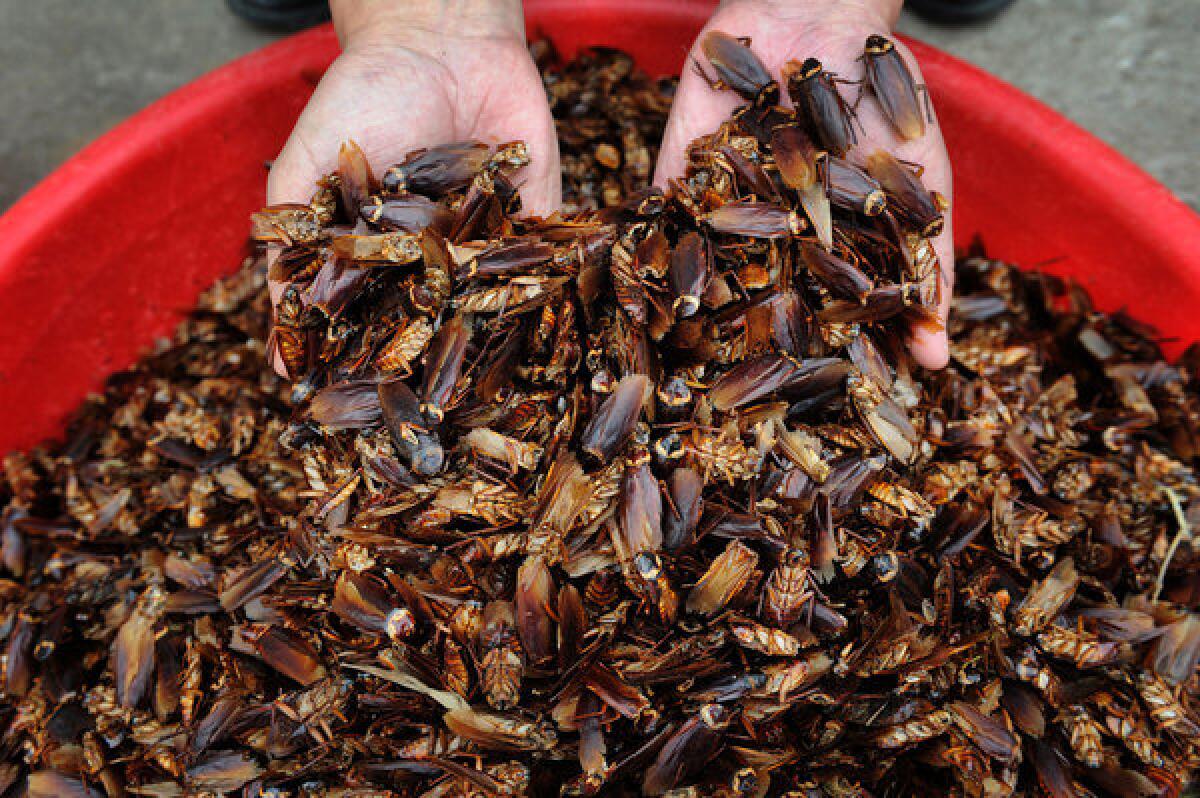On safari for San Pedro’s invasive lizards

A team is crawling the streets to learn more about Italian wall lizards, a newly arrived species that’s quickly dominated natives in the area.
- Share via

G
reg Pauly grabs a 12-foot pole out of the back of his truck and checks to make sure the little green noose at the end is still in working order.
It's easier to noose a lizard than pounce on it, he explains.
Pauly, the curator of herpetology at the Natural History Museum of Los Angeles, has caught snakes in the mountains of Venezuela and studied frogs in the Panamanian rain forest. Today, however, he'll be collecting specimens a little closer to home — scouring backyards and telephone poles in the not-so-wilds of San Pedro for bright green Italian wall lizards.
Joining Pauly on the lizard hunt are high school sophomore Hayden Kirschbaum and Hayden's dad, Kenneth.
Hayden got a small grant from the Southern California Academy of Sciences to work with Pauly on the wall lizard project, and so one Sunday a month the Kirschbaums make the drive from their home in Santa Monica for this urban safari.
"Some fathers play ball with their sons," Kenneth says. "We noose lizards. It's still father-son time."
I basically have a job...that allows me to be a 5-year-old for the rest of my life."— Greg Pauly, Natural History Museum of Los Angeles curator of herpetology
Pauly has also invited nature enthusiast and longtime San Pedro resident Jim Hall to tag along. Hall ambles up to the group. Wearing a field vest and sneakers and smiling beneath a white mustache, he says:
"Looks like lizard hunters."

The Italian wall lizard is a relative newcomer to Southern California. It's thin and elegant, and some of the showier males have a dot of brilliant turquoise on their sides.
The wall lizards arrived in San Pedro in 1994, when a homeowner brought a few of them back from a trip to Sicily. He released four males and three females into his backyard, and they thrived and multiplied.
Nearly 20 years later, the Italian wall lizards have almost entirely replaced native lizards in a five-block radius from where they were introduced.
"Since I started studying this population, I've seen literally a thousand wall lizards in this area and just two native lizards," says Pauly, 36, who's decked out in a pair of Tevas and a pale blue T-shirt that says, "Newt and Improved." "The takeover feels pretty complete."

Greg Pauly holds one of the Italian wall lizards, which were introduced to San Pedro in 1994 and have replaced native lizards over an area of several blocks. (Anne Cusack / Los Angeles Times) More photos
Hundreds of invasive species have wiped out native flora and fauna all over the world, and Pauly wants to keep that from happening to the native lizards of Southern California. Capturing 10 or 12 lizards a month won't stop the invasion on its own, but Pauly believes it's a first step.
"The question is, what becomes established, and then what impacts are they having on our native species?" he says. "We can't do any studies on how invasive lizards are impacting native lizards if we don't know that they are here. It's pretty scary that we still don't have a good idea of the biodiversity of L.A."
Since Memorial Day, Pauly has made the monthly trips to San Pedro to determine how widely the lizard has spread and to collect specimens to bring back to the museum. Tragically — for the lizards, at least — they survive the noose only to be dispatched with a shot of poison to the heart.
This winter, when the cold-blooded lizards are dormant and harder to collect, he will turn his attention to the ones he's already caught and preserved — analyzing the contents of their stomachs and intestinal tracts to determine whether they are stealing native lizards' food, preying on them, or carrying parasites that might be killing them off.
Ultimately, he wants to know why this particular lizard has so successfully dominated the native lizards in the area.
Friendly and talkative, Pauly is deeply enthusiastic about his work.
"I basically have a job," he says, "that allows me to be a 5-year-old for the rest of my life."

The lizard hunters' first stop is a rock pile behind the home of Alan Miller, a retired ecologist who recently responded to one of the fliers that Pauly put in mailboxes throughout the neighborhood that had pictures of three lizards under the words "HAVE YOU SEEN ME?"
Miller emailed Pauly to say he first noticed Italian wall lizards sunning themselves on his rock pile two years ago.

Robert Espinoza, herpetologist and professor at Cal State Northridge, searches for a species of lizard in San Pedro during an outing with Greg Pauly in June. (Lawrence K. Ho / Los Angeles Times) More photos
Miller stacks wood in preparation for a family barbecue as the lizard hunters spread out around his yard, panfish poles bouncing on their shoulders.
Noosing a lizard takes time and patience. "They are really good at seeing the noose and they are kind of hard to catch," Pauly says.
They're also nimble — jumping through the little green loops (leaping lizards!) or darting away just when you think you've got one.
One benefit of hunting Italian wall lizards is that they tend to stay in the same place. Hang around a wall lizard's hiding place for a few minutes and it's bound to pop back out.
The lizard hunters spot several babies in Miller's yard, but Pauly deems them too small to noose, so, empty-handed, they decide to move on.
"But we've still learned a valuable lesson, that they are here," Pauly says. "We know they've spread this far, at least."

Pauly is a busy guy. As curator of herpetology at the museum, he is expected to do his own research, manage the museum's reptile and amphibian collection of 184,000 preserved specimens, and work on exhibits such as the newly opened Nature Lab.
The museum is supportive of his work on the urban lizard safaris, but is not exactly subsidizing it.
"Who pays the bills when I drive out to San Pedro? I do," he says. "But I do that because you can't get a grant unless you have some preliminary data.... And we have a good time, and we get to do some cool science."
The Italian wall lizards aren't the only introduced species Pauly has documented in the L.A. area. Over the summer, he made regular visits to Chatsworth, where a few years ago an observant 9-year-old helped him uncover a population of Mediterranean house geckos. He also collected an unrecorded population of green anoles on a ritzy street in the Hancock Park neighborhood, and found established populations of the Indo-Pacific gecko in Torrance and Lake Forest in Orange County.
"What we've shown this past summer is there are a ton of these introduced species in Southern California," Pauly says. "Now we want to know what kind of impact they are having."

Kenneth Kirschbaum strikes up a conversation with San Pedro homeowner Kristen Croft, and before long she's invited the whole crew to explore her concrete-covered backyard.
"We see those lizards all the time," says her husband, Andy, as the lizard hunters fan out across the yard. "They sun themselves on our fire pit."
Pauly spots a wall lizard on the top of a fence and borrows a ladder. Slowly he extends the noose toward the lizard's head, gently working the thin loop around its neck. With the noose in place he pulls tight, and the lizard dangles off his pole, its little legs flailing.
Pauly puts the lizard in a plastic baggie with a slip of paper on which he has written the time of day and the address of the Crofts' house. Before heading back to the museum, he will inject a tiny amount of poison into its heart.

Hayden Kirschbaum moves in to catch an Italian wall lizard during a hunt for the non-native species in San Pedro. The lizards are bagged, euthanized and brought to the Natural History Museum for study. (Anne Cusack / Los Angeles Times) More photos
"It's super fast and it's super painless," he says. "You don't get into this line of work because you want to kill animals. Every time I think, 'Does this animal need to be sacrificed?'"
He euthanizes them in the field to preserve as much gut content as possible. "Every time one poops, we lose data," he says.
Pauly and the Kirschbaums have been invited into about 20 backyards in this community throughout the summer, but not all residents are welcoming. Some have come to love the svelte green lizards and don't want Pauly euthanizing them. As the team moves closer to the street where the wall lizards were introduced, Pauly points out half a dozen houses that are off-limits.
Two hours after the lizard hunt began, the group arrives at ground zero of the wall lizard invasion, where the lizards were first released. By now, even first-time lizard hunter Jim Hall has become adept at spotting them. And they are everywhere.
"It's probably the most lizards you've ever seen in one area, right?" Pauly says.
The group spots five scampering around one telephone pole. Hayden nabs one on a low concrete wall, and his dad nooses one along a driveway. And novice nooser Hall gets his first lizard.
By the end of the expedition, they have more than 10 lizards in zip-lock baggies ready to go into the museum's collection. It's been a pretty good day.
Follow Deborah Netburn (@DeborahNetburn) on Twitter
Follow @latgreatreads on Twitter
More great reads
Cockroach farms multiplying in China

People laughed at me when I started, but I always thought that cockroaches would bring me wealth."
Seems as if all of Fresno has adopted the Bulldogs

The thing about Fresno is, we’re a very large city but we still have that small-town feeling."
Raising the feel-good energy at Peace Yoga

I really hate touching money. ... I prefer to have an exchange of energy, not paper."




